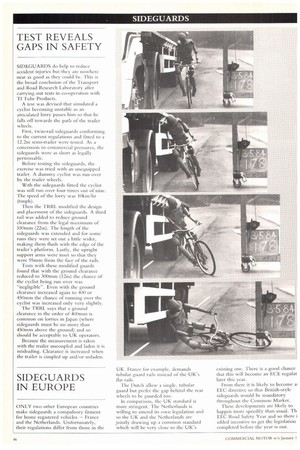TEST REVEALS GAPS IN SAFETY
Page 46

If you've noticed an error in this article please click here to report it so we can fix it.
SIDEGUARDS do help to reduce accident injuries but they are nowhere near as good as they could be. This is the broad conclusion of the Transport and Road Research Laboratory after carrying out tests in co-operation with TI Tube Products.
A test was devised that simulated a cyclist becoming unstable as an articulated lorry passes him so that he falls off towards the path of the trailer wheels.
First, twin-rail sideguards conforming to the current regulations and fitted to a 12.2m semi-trailer were tested. As a concession to commercial pressures, the sideguards were as short as legally permissable.
Before testing the sideguards, the exercise was tried with an unequipped trailer. A dummy cyclist was run over by the trailer wheels.
With the sideguards fitted the cyclist was still run over four times out of nine. The speed of the lorry was 10km/hr (6mph).
Then the TRRL modified the design and placement of the sideguards. A third rail was added to reduce ground clearance from the legal maximum of 550nim (22in). The length of the sideguards was extended and for sonic runs they were set out a little wider, making them flush with the edge of the trailer's platform. Lastly, the upright support arms were inset so that they were 95mrn from the face of the rails.
Tests with these modified guards found that with the ground clearance reduced to 300mm (12in) the chance of the cyclist being run over was "negligible". Even with the ground clearance increased again to 400 or 450mm the chance of running over the cyclist was increased only very slightly.
The TRRL says that a ground clearance in the order of 400mna is common on lorries in Japan (where sideguards must be no more than 450mm above the ground) and so should be acceptable to UK operators.
Because the measurement is taken with the trailer uncoupled and laden it is misleading. Clearance is increased when the trailer is coupled up and/or unladen.






















































